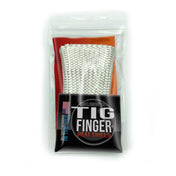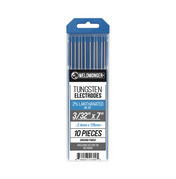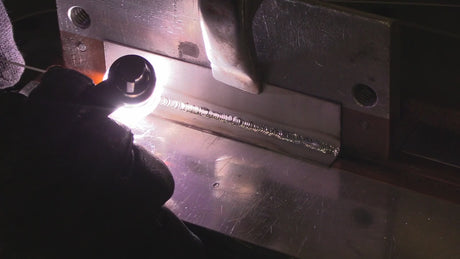IMPORTANT!
THIS IS A CONDENSED VERSION OF A MATERIAL SAFETY DATA SHEET
(MSDS).
READ THE FULL MSDS (below) BEFORE USING THIS PRODUCT
WARNING: PRODUCT COMPONENTS PRESENT HEALTH AND SAFETY HAZARDS. READ AND UNDERSTAND THIS LITERATURE. ALSO, FOLLOW
YOUR EMPLOYER’S SAFETY PRACTICES. The information contained herein relates only to the specific product. If the product is combined with other
materials, all component properties must be considered. BE SURE TO CONSULT THE LATEST EDITION OF THE FULL MATERIAL SAFETY DATA SHEETS
(MSDS). MATERIAL SAFETY DATA SHEETS ARE AVAILABLE FROM Weldmonger Enterprises INC, STATEMENT OF LIABILITY – DISCLAIMER
STATEMENT OF LIABILITY – DISCLAIMER To the best of Weldmonger Enterprises INC, knowledge, the information and recommendations contained in this publication are reliable and accurate as of the date prepared. However, accuracy, suitability, or completeness are not guaranteed, and no warranty, guarantee, or representation, expressed or implied is made by Weldmonger Enterprises INC, as to the absolute correctness or sufficiency of any representation contained in this and other publication. Weldmonger Enterprises INC, assumes no responsibility in connection therewith; nor can it be assumed that all acceptable safety measures are contained in this and other publications, or that other or additional measures may not be required under particular or exceptional conditions or circumstances. Data may be changed from time to time. CAUTION! FUMES MAY BE HARMFUL IF INHALED. FUMES CAN CAUSE RESPIRATORY, SKIN AND EYE IRRITATION. HOT ELECTRODES CAN CAUSE THERMAL BURNS.
SUMMARY OF IMPORTANT SAFE-WORK PRACTICES
• Do not get on skin or in eyes. Keep out of reach of children.
• Avoid breathing fumes. Keep head away from fumes.
• Exhaust at the flame or heat source to keep fumes and gases from breathing zone and general area.
• Wash thoroughly after handling.
• Wear gloves, goggles, face-shields, suitable body protection, and NIOSH-approved respiratory protection, as appropriate.
• For maximum safety, be certified for and wear a respirator at all times during welding operations.
See American National Standard Z49.1, Safety in Welding, Cutting, and Allied Processes, published by the American Welding Society, 550 NW LeJeune Rd., Miami,
FL 33126. Also see OSHA Safety and Health Standards, 29 CFR 1910, available from the US Government Printing Office. Washington DC, 20401.
FL 33126. Also see OSHA Safety and Health Standards, 29 CFR 1910, available from the US Government Printing Office. Washington DC, 20401.
SECTION 1 - PRODUCT IDENTIFICATION
IDENTIFICATION
Manufacturer/Supplier Name: Weldmonger Enterprises INC,
Address: PO Box 801068 Acworth, GA 30101
Website: www.weldmonger.com
Emergency Telephone No. 833-308-7018
Information Telephone No. 833-308-7018 Option 3
Product Type: TUNGSTEN ELECTRODE
Product For: WL20
AWS Specification: ¢1.6X175¢2.4X175¢3.2X175
PI NO.:UPT2011113
MSDS Version Number 2
Date of Preparation Dec-27-2020
SECTION 2 - COMPOSITION and INFORMATION ON INGREDIENTS
|
TRADE NAME |
Tip Color |
W (Min.) |
CeO2 |
La2O3 |
ThO2 |
ZrO2 |
|
PURE TUNGSTEN |
Green |
99.5 |
|
|
|
|
|
1% THORIATED TUNGSTEN |
Yellow |
98.3 |
0.8-1.2 |
|
|
|
|
2% THORIATED TUNGSTEN |
Red |
97.3 |
1.7-2.2 |
|
|
|
|
1% LANTHANATED TUNGSTEN |
Black |
98.3 |
0.8-1.2 |
|
|
|
|
1.5% LANTHANATED TUNGSTEN |
Gold |
97.8 |
1.3-1.7 |
|
|
|
|
2% LANTHANATED TUNGSTEN |
Blue |
97.3 |
1.8-2.2 |
|
|
|
|
2% CERIATED TUNGSTEN |
Gray |
97.3 |
1.8-2.2 |
|
|
|
|
0.3% ZIRCONIATED TUNGSTEN |
Brown |
99.1 |
0.15-0.40 |
|
|
|
EXPOSURE INFORMATION
|
CHEMICAL |
CAS # |
ACGIH-TLV |
OSHA-PEL |
NIOSH-REL |
|
Tungsten |
7440-33-7 |
TWA = 5 |
TWA = 5 (Vacated 1989 PEL) |
TWA = 5 |
|
Cerium Oxide (CeO2) |
1306-38-3 |
NE |
NE |
NE |
|
Lanthanum Oxide (La2O3) |
1312-81-8 |
NE |
NE |
NE |
|
Thorium Oxide (ThO2) |
1314-20-1 |
NE |
NE |
NE |
|
Zirconium Oxide (ZrO2) |
1314-23-4 |
TWA = 5, A4 (Not Classifiable as a Human |
TWA = 5 |
TWA = 5 |
NE = Not Established.
NOTE: Fumes may be generated during the use of these electrodes. To appropriately assess inhalation hazards, one recommended way to determine the
composition and quantity of fumes and gases to which workers are exposed is to take an air sample in the workers breathing zone. See ANSI/AWS F1.1, from the
American Welding Society, 550 NW LeJeune Rd., Miami, FL 33126.
SARA SECTION 313 SUPPLIER INFORMATION: These products contain the following chemicals subject to the reporting requirements of Section 313 of the
Emergency Planning and Community Right-To-Know Act of 1986 (per 40 CFR 372). Thorium Oxide
SECTION 3 - HAZARD IDENTIFICATION
There are no immediate hazards with these electrodes. The chief acute health hazard associated with these products is inhalation of fumes during welding
operations. The Inhalation of fumes generated by welding or dusts and powders, formed if grinding operations are performed on the product. Those electrodes that
contain Thorium Oxide have a special hazard if dusts or powders are produced and inhaled during use or grinding of tips of the electrodes, as thorium compounds are
suspected of being cancer-causing compounds. When exposed to extremely high temperatures, these products will produce irritating oxides of cerium, thorium,
tungsten and zirconium. These electrodes present no significant fire hazard; however finely divided metal powder which may be generated during grinding of the tips
of electrodes, is highly flammable (especially when exposed to oxidizing compounds at elevated temperatures). In some circumstances, powdered tungsten can be
spontaneously flammable.
CARCINOGENICITY STATUS: Chemicals in these electrodes are listed, as follows.
THORIUM OXIDE: IARC-1, Carcinogenic to Humans ZIRCONIUM OXIDE: TLV-A4, Not Classifiable as to Human Carcinogenicity
The other components of these products are not found on the following lists: FEDERAL OSHA Z LIST, NTP, IARC, and CAL/OSHA, and therefore are not
considered to be, nor suspected to be, cancer-causing agents by these agencies.
CALIFORNIA SAFE DRINKING WATER AND TOXIC ENFORCEMENT ACT (PROPOSITION 65): Thorium Oxide is a component of some of these alloys and is
on the Proposition 65 list. The State of California requires the following information: WARNING: This product may contain chemicals, and when used
for welding may produce fumes or gases containing chemicals, known to the State of California to cause cancer, and/or birth defects (or other
reproductive harm.)
SECTION 4 - FIRST-AID MEASURES
SKIN: If the product’s fumes irritate the skin, begin decontamination with running water. Minimum flushing is for 15 minutes.
EYES: If the product’s fumes irritate the eyes, flush eyes under gently running water. Minimum flushing is for 15 minutes.
INHALATION: Move victim to fresh air. If necessary, use artificial respiration.
INGESTION: If swallowed call physician immediately! Do not induce vomiting unless directed by medical personnel. Rinse mouth with water if person is conscious.
Never give fluids or induce vomiting if person is unconscious, having convulsions, or not breathing.
VICTIMS OF CHEMICAL EXPOSURE MUST BE TAKEN FOR MEDICAL ATTENTION, ESPECIALLY IF ADVERSE EFFECTS CONTINUE AFTER FIRST-AID
TREATMENT. REFER TO SECTION 11 FOR ADDITIONAL TREATMENT INFORMATION!
SECTION 5 - FIRE-FIGHTING MEASURES
For Electrode:
FLASH POINT: Not applicable
AUTOIGNITION TEMPERATURE: Not determined.
FLAMMABLE LIMITS: Not applicable
FIRE EXTINGUISHING MATERIALS:

|
Water Spray : |
YES (for cooling) Carbon Dioxide: YES |
|
YES |
Foam: YES |
|
Dry Chemical: YES |
|
For Powders of Tungsten: Powders of Tungsten are considered
to be a Class D Fires. Use Soda Ash, Lime, DRY Sand (Purple K,
if available). DO NOT USE WATER
EXPLOSION SENSITIVITY TO MECHANICAL IMPACT: Not sensitive.
EXPLOSION SENSITIVITY TO STATIC DISCHARGE: The finely divided powders of these products may ignite if exposed to static electrical discharge.
FIRE HAZARDS: During a fire, irritating fumes (e.g., tungsten oxide compounds) may be generated.
FIRE-FIGHTING PROCEDURES: Structural firefighters must wear Self-Contained Breathing Apparatus and full protective equipment.
UNUSUAL FIRE AND EXPLOSION HAZARDS: When Thorium Oxide-containing electrodes are involved in a fire, incipient fire fighters must wear a respirator
approved for radionuclides. When exposed to extremely high temperatures, these products will produce irritating oxides of cesium, thorium, tungsten and zirconium
(depending on composition - see Section 2, Composition and Information on Ingredients). These electrodes present no significant fire hazard. Finely divided
tungsten powder, however, is highly flammable (especially when exposed to oxidizing compounds at elevated temperatures).
SECTION 6 - ACCIDENTAL RELEASE MEASURES
Not applicable.
SECTION 7 - HANDLING and STORAGE
All employees who handle these materials should be trained to handle them safely. Avoid breathing fumes during welding operations. Store these electrodes in a
cool, dry location, away from direct sunlight, sources of intense heat, or where freezing is possible. Store away from incompatible chemicals (see Section 10,
Stability and Reactivity). Inspect all incoming containers before storage to ensure they are properly labeled and not damaged. If these products are used during
welding operations, it is recommended that the requirements of the Federal Occupational Safety and Health Welding and Cutting Standard (29 CFR 1910 Subpart Q)
and the Standards of the American National Standards Institute for Welding and Cutting (ANSI Z49.1) be followed. Use ventilation and other engineering controls to
minimize potential exposure to fumes during welding operations or to dusts if tips of electrodes are ground. Follow good housekeeping practices to ensure powders
or dusts from grinding operations do not accumulate, which can be highly flammable and can pose special health hazards if from thorium-containing electrodes.
Tungsten-Thorium Oxide alloys are generally safe to handle during use and almost all normal conditions and environments. Special precautions must be taken
during the grinding or machining of tips of electrodes that contain Thorium Oxide to avoid the generation and subsequent inhalation of dusts from these
operations. Any dusts generated during these operations may be considered as “Source Material”, as defined by the Nuclear Regulatory Commission,
and therefore be subject to the requirements of 10 CFR, Parts 20 and 40. Routine wet mopping or vacuuming with an explosion-proof vacuum, fitted with a
HEPA filter may be considered to reduce accumulation of dusts.
SECTION 8 - EXPOSURE CONTROLS - PERSONAL PROTECTION
VENTILATION AND ENGINEERING CONTROLS: Use with adequate ventilation to ensure exposure levels are maintained below the limits provided in Section 2
(Composition and Information on Ingredients). Ensure eyewash/safety shower stations are available.
RESPIRATORY PROTECTION: If respiratory protection is needed, use only protection authorized in the U.S. Federal OSHA Standard (29 CFR 1910.134),
applicable U.S. State regulations, or the appropriate standards of Canada and its Provinces. It is suggested that NIOSH guidelines for Welding Fumes are followed.
For further information, see full MSDS for these products.
EYE PROTECTION: Safety glasses. When used during welding, wear safety glasses, goggles or faceshield with filter lens of appropriate shade number. (see
ANSI Z49.1, “Safety in Welding and Cutting”), as necessary.
HAND PROTECTION: Wear gloves that will protect against heat of metal product.
BODY PROTECTION: None needed for normal circumstances of use. Use body protection appropriate for task (i.e., leather apron, and coveralls).
SECTION 9 - PHYSICAL and CHEMICAL PROPERTIES
VAPOR DENSITY : Not applicable.
EVAPORATION RATE: Not applicable.
SPECIFIC GRAVITY (water = 1) : 19.3.
MELTING POINT: 3410°C (6170°F).
|
SOLUBILITY IN WATER: |
Insoluble. |
BOILING POINT: 5927°C (10701°F). |
|
VAPOR PRESSURE: Not applicable. |
pH: |
Not applicable |
APPEARANCE AND COLOR: These electrodes are hard, brittle, silvery-gray, odorless metal electrodes.
SECTION 10 - STABILITY and REACTIVITY
STABILITY: Stable.
DECOMPOSITION PRODUCTS: Tungsten oxide compounds may be generated.
MATERIALS WITH WHICH PRODUCTS ARE INCOMPATIBLE: Tungsten is not compatible with halogens and strong oxidizers (i.e. sulfuric acid, nitric acid).
HAZARDOUS POLYMERIZATION: Will not occur.
SECTION 11 - OTHER USEFUL INFORMATION
RECOMMENDATIONS TO PHYSICIANS: When personnel have chronic exposure to dusts from electrodes that contain Thorium Oxide, monitoring of personnel for
early symptoms and changes such as abnormal leukocytes in the blood smear may be of value. In cases of chronic or acute exposure, the determination of thorium in
the urine or the use of whole body radiation counts & breath radon are useful methods of monitoring the exposure dose and excretion rates.
PREPARING WASTES FOR DISPOSAL: Waste disposal must be in accordance with appropriate U.S. Federal, State, and local regulations or with regulations of
Canada and its Provinces. Refer to Material Safety Data Sheet for more specific information on waste disposal.
ADDITIONAL U.S. AND CANADIAN REGULATIONS: Various other U.S. Federal and State Standards (or those of Canada and its Provinces) may be
pertinent to the safe use, storage, and disposal, and regulatory reporting requirements. Refer to the Material Safety Data Sheet for more specific
information.
TRANSPORTATION REGULATIONS: : Not regulated under current U.S. DOT regulations.
IMPORTANT!
(MSDS). MATERIAL SAFETY DATA SHEETS ARE AVAILABLE AT WELDMONGER.COM/MSDS
SUMMARY OF IMPORTANT SAFE-WORK PRACTICES
• Do not get on skin or in eyes. Keep out of reach of children.
• Avoid breathing fumes. Keep head away from fumes.
• Exhaust at the flame or heat source to keep fumes and gases from breathing zone and general area.
• Wash thoroughly after handling.
• Wear gloves, goggles, face-shields, suitable body protection, and NIOSH-approved respiratory protection, as appropriate.
• For maximum safety, be certified for and wear a respirator at all times during welding operations.
See American National Standard Z49.1, Safety in Welding, Cutting, and Allied Processes, published by the American Welding Society, 550 NW LeJeune Rd., Miami, FL 33126. Also see OSHA Safety and Health Standards, 29 CFR 1910, available from the US Government Printing Office. Washington DC, 20401.
Information Telephone No. 833-308-7018
SECTION 2 – HAZARDOUS INGREDIENTS
|
Componets |
CAS No. |
PEL.Si/m3 |
TLV.Si/m3 |
Wt.% |
|
Manganese(fume) |
7439-96-5 |
5 |
0.2 |
<2 |
|
Silicon |
7440-21-3 |
5(respirable) 15(dust) |
5(respirable) |
0.5-2.0 |
|
Iron(oxide fume) |
1309-37-1 |
10 |
5 |
Balance |
|
(fume) |
7440-50-8 |
0.1 |
0.2 |
<0.5 |
|
Componets |
CAS No. |
PEL.Si/m3 |
TLV.Si/m3 |
Wt.% |
|
Manganese(fume) |
7439-96-5 |
5 |
0.2 |
<2 |
|
Silicon |
7440-21-3 |
5(respirable) 15(dust) |
10(respirable) |
0.5-2.0 |
|
Iron(oxide fume) |
1309-37-1 |
10 |
5 |
Balance |
|
(fume) |
7440-50-8 |
0.1 |
0.2 |
<0.5 |
|
CHEMICAL COMPOSITION(%) |
||||||||||||||||||||||
|
Elements |
C |
Mn |
Si |
Ti |
Al |
P |
S |
Cu |
|
|
|
|
|
|||||||||
|
Requirement |
-- |
-- |
-- |
-- |
-- |
-- |
-- |
-- |
|
|
|
|
|
|||||||||
|
Test Result
|
0.050 |
1.38 |
0.65 |
0.11 |
0.07 |
0.018 |
0.010 |
0.18 |
|
|
|
|
|
|||||||||
|
|
Tensile Test of Deposited metal |
Impact Test of Deposited Metal |
Soundness Test |
Welding Condition |
Postweld Heat Treatment
|
|||||||||||||||||
|
Yield Point Mpa(σ0.2) |
Tensile Strength Mpa(σb) |
Elongation %(δ5) |
Test Temp ℃ |
Impact(Ave) J |
Type of Current |
Amperage |
Are Voltage
|
Shielding Gas Or Flux |
||||||||||||||
|
Requirement |
≥500 |
≥420 |
≥22 |
-30℃ |
-- |
-- |
DC+ |
80-350 |
— |
--- |
— |
|||||||||||
|
Test Result |
550 |
450 |
26 |
-30℃ |
160 |
-- |
DC+ |
80-350 |
— |
--- |
— |
|||||||||||
|
CHEMICAL COMPOSITION(%) |
||||||||||||||||||||||
|
Elements |
C |
Mn |
Si |
Ti |
Al |
P |
P |
S |
Cu |
V |
|
|
|
|||||||||
|
Requirement |
0.06-0.15 |
1.40-1.85 |
0.80-1.15 |
≤0.15 |
≤0.15 |
≤0.15 |
≤0.025 |
≤0.025 |
≤0.50 |
≤0.03 |
|
|
|
|||||||||
|
Test Result
|
0.08 |
1.49 |
0.84 |
0.032 |
0.019 |
0.004 |
0.018 |
0.018 |
0.15 |
0.15 |
|
|
|
|||||||||
|
|
Tensile Test of Deposited metal |
Impact Test of Deposited Metal |
Soundness Test |
Welding Condition |
Postweld Heat Treatment
|
|||||||||||||||||
|
Yield Point Mpa(σ0.2) |
Tensile Strength Mpa(σb) |
Elongation %(δ5) |
Test Temp ℃ |
Impact(Ave) J |
Type of Current |
Amperage |
Are Voltage
|
Shielding Gas Or Flux |
||||||||||||||
|
Requirement |
≥500 |
≥420 |
≥22 |
-30℃ |
≥27 |
-- |
DC+ |
80-350 |
— |
--- |
— |
|||||||||||
|
Test Result |
545 |
445 |
267 |
-30℃ |
99.91.103 |
-- |
DC+ |
80-350 |
— |
--- |
— |
|||||||||||
|
Hazardous Components(specific Chemical Identity): |
CASNo. |
%By Weight |
TLV(mg/m3)
|
|
Iron: |
7439-89-6 |
Bal. |
10AsFe2O3 |
|
Silicon |
7440-44-0 |
0-1.0 |
2 |
|
Manganese |
7440-21-3 |
0-1.20 |
|
|
Sulfur |
7439-96-5 |
0-14 |
1 |
|
Phosphorous |
7704-34-9 |
0-0.50 |
0.2 |
|
Chrommium |
7723-14-0 |
0-0.50 |
10 |
|
Molybdenum |
7440-47-3 |
11.5-37.0 |
0.05 Chromium VI |
|
Nickel |
7439-98-7 |
0.05-6.0 |
10 |
|
Copper |
7440-50-6 |
0-5.0 |
N/A |
|
Vanadium |
7440-62-2 |
N/A |
N/A |
SECTION 3-PHYSICAL/CHEMICAL CHARACTERISTICS
|
Boiling Point N/A |
Specific Gravity(H2O=1 N/A |
|
Vapor Pressure(mm Hg) N/A |
Melting Point N/A |
|
Vapor Density(AIR=1) N/A |
Evaporation Rate (Butyl Acetate=1) N/A |
|
Solubility in Water N/A |
|
|
Appearance and Odor Stainless steel wire, shine silver appearance, Odorless |
|





